Numerical Investigation of Perovskite/Silicon Heterojunction Tandem Solar Cell with a Dual-Functional Layer of MoOX
Abstract
1. Introduction
2. Methods
2.1. Simulation Methodology
2.2. Device Structure
3. Results and Discussion
3.1. Effect of Different Recombination Layers
3.2. Effect of SnO2/MoOX Recombination Layer on Device Performance
3.2.1. Effect of the Carrier Concentration of the Recombination Layer
3.2.2. Effect of the Defect Density at the SnO2/MoOX Interface
3.2.3. Effect of the Thickness of the Recombination Layer
3.3. Effect of Different HTLs on the Top Cell
3.4. Effect of the Thicknesses of Perovskite and Silicon Absorption Layers
3.5. Effect of the Defect Density of the Perovskite Absorber Layer
3.6. Effect of Bottom Cell Texture Structure
4. Conclusions
Author Contributions
Funding
Institutional Review Board Statement
Informed Consent Statement
Data Availability Statement
Conflicts of Interest
References
- Wu, H.; Ye, F.; Yang, M.; Luo, F.; Tang, X.; Tang, Q.; Qiu, H.; Huang, Z.; Wang, G.; Sun, Z.; et al. Silicon heterojunction back-contact solar cells by laser patterning. Nature 2024, 635, 604–609. [Google Scholar] [CrossRef]
- Richter, A.; Hermle, M.; Glunz, S.W. Reassessment of the Limiting Efficiency for Crystalline Silicon Solar Cells. IEEE J. Photovolt. 2013, 3, 1184–1191. [Google Scholar] [CrossRef]
- Kojima, A.; Teshima, K.; Shirai, Y.; Miyasaka, T. Organometal Halide Perovskites as Visible-Light Sensitizers for Photovoltaic Cells. J. Am. Chem. Soc. 2009, 131, 6050–6051. [Google Scholar] [CrossRef] [PubMed]
- Green, M.A.; Dunlop, E.D.; Yoshita, M.; Kopidakis, N.; Bothe, K.; Siefer, G.; Hao, X.; Jiang, J.Y. Solar Cell Efficiency Tables (Version 65). Prog. Photovoltaics Res. Appl. 2025, 33, 3–15. [Google Scholar] [CrossRef]
- Liang, C.; Gu, H.; Xia, Y.; Wang, Z.; Liu, X.; Xia, J.; Zuo, S.; Hu, Y.; Gao, X.; Hui, W.; et al. Two-dimensional Ruddlesden–Popper layered perovskite solar cells based on phase-pure thin films. Nat. Energy 2021, 6, 38–45. [Google Scholar] [CrossRef]
- Heydarian, M.; Messmer, C.; Bett, A.J.; Heydarian, M.; Chojniak, D.; Kabaklı, Ö.Ş.; Tutsch, L.; Bivour, M.; Siefer, G.; Schubert, M.C.; et al. Maximizing Current Density in Monolithic Perovskite Silicon Tandem Solar Cells. Sol. RRL 2023, 7, 2200930. [Google Scholar] [CrossRef]
- Jacobsson, T.J.; Hultqvist, A.; Svanström, S.; Riekehr, L.; Cappel, U.B.; Unger, E.; Rensmo, H.; Johansson, E.M.J.; Edoff, M.; Boschloo, G. 2-Terminal CIGS-perovskite tandem cells: A layer by layer exploration. Sol. Energy 2020, 207, 270–288. [Google Scholar] [CrossRef]
- Maksudov, T.; He, M.; Doukas, S.; Nugraha, M.I.; Adilbekova, B.; Faber, H.; Luo, L.; Zhou, R.; Bakr, O.M.; Ogieglo, W.; et al. 23.6% Efficient perovskite-organic tandem photovoltaics enabled by recombination layer engineering. Mater. Sci. Eng. R. Rep. 2024, 159, 100802. [Google Scholar] [CrossRef]
- Hossain, M.I.; Saleque, A.M.; Ahmed, S.; Saidjafarzoda, I.; Shahiduzzaman, M.; Qarony, W.; Knipp, D.; Biyikli, N.; Tsang, Y.H. Perovskite/perovskite planar tandem solar cells: A comprehensive guideline for reaching energy conversion efficiency beyond 30%. Nano Energy 2021, 79, 105400. [Google Scholar] [CrossRef]
- Al-Ashouri, A.; Köhnen, E.; Li, B.; Magomedov, A.; Hempel, H.; Caprioglio, P.; Márquez, J.A.; Vilches, A.B.M.; Kasparavicius, E.; Smith, J.A.; et al. Monolithic perovskite/silicon tandem solar cell with >29% efficiency by enhanced hole extraction. Science 2020, 370, 1300–1309. [Google Scholar] [CrossRef]
- Tockhorn, P.; Sutter, J.; Cruz, A.; Wagner, P.; Jaeger, K.; Yoo, D.; Lang, F.; Grischek, M.; Li, B.; Li, J.; et al. Nano-optical designs for high-efficiency monolithic perovskite-silicon tandem solar cells. Nat. Nanotechnol. 2022, 17, 1214–1221. [Google Scholar] [CrossRef] [PubMed]
- Hou, Y.; Aydin, E.; De Bastiani, M.; Xiao, C.; Isikgor, F.H.; Xue, D.-J.; Chen, B.; Chen, H.; Bahrami, B.; Chowdhury, A.H.; et al. Efficient tandem solar cells with solution-processed perovskite on textured crystalline silicon. Science 2020, 367, 1135. [Google Scholar] [CrossRef] [PubMed]
- Mailoa, J.P.; Bailie, C.D.; Johlin, E.C.; Hoke, E.T.; Akey, A.J.; Nguyen, W.H.; McGehee, M.D.; Buonassisi, T. A 2-terminal perovskite/silicon multijunction solar cell enabled by a silicon tunnel junction. Appl. Phys. Lett. 2015, 106, 121105. [Google Scholar] [CrossRef]
- Best Research-Cell Efficiency Chart. Available online: https://www.nrel.gov/pv/cell-efficiency.html (accessed on 2 January 2025).
- De Bastiani, M.; Subbiah, A.S.; Aydin, E.; Isikgor, F.H.; Allen, T.G.; De Wolf, S. Recombination junctions for efficient monolithic perovskite-based tandem solar cells: Physical principles, properties, processing and prospects. Mater. Horiz. 2020, 7, 2791–2809. [Google Scholar] [CrossRef]
- Ying, Z.; Yang, Z.; Zheng, J.; Wei, H.; Chen, L.; Xiao, C.; Sun, J.; Shou, C.; Qin, G.; Sheng, J.; et al. Monolithic perovskite/black-silicon tandems based on tunnel oxide passivated contacts. Joule 2022, 6, 2644–2661. [Google Scholar] [CrossRef]
- Ying, Z.Q.; Yang, X.; Zheng, J.M.; Zhu, Y.D.; Xiu, J.W.; Chen, W.; Shou, C.H.; Sheng, J.; Zeng, Y.H.; Yan, B.J.; et al. Charge-transfer induced multifunctional BCP:Ag complexes for semi-transparent perovskite solar cells with a record fill factor of 80.1%. J. Mater. Chem. A 2021, 9, 12009–12018. [Google Scholar] [CrossRef]
- Palmstrom, A.F.; Eperon, G.E.; Leijtens, T.; Prasanna, R.; Habisreutinger, S.N.; Nemeth, W.; Gaulding, E.A.; Dunfield, S.P.; Reese, M.; Nanayakkara, S.; et al. Enabling Flexible All-Perovskite Tandem Solar Cells. JOULE 2019, 3, 2193–2204. [Google Scholar] [CrossRef]
- Kabakli, O.S.; Kox, J.; Tutsch, L.; Heydarian, M.; Bett, A.J.; Lange, S.; Fischer, O.; Hagendorf, C.; Bivour, M.; Hermle, M.; et al. Minimizing electro-optical losses of ITO layers for monolithic perovskite silicon tandem solar cells. Sol. Energy Mater. Sol. Cells 2023, 254, 112246. [Google Scholar] [CrossRef]
- Sahli, F.; Kamino, B.A.; Werner, J.; Bräuninger, M.; Paviet-Salomon, B.; Barraud, L.; Monnard, R.; Seif, J.P.; Tomasi, A.; Jeangros, Q.; et al. Improved Optics in Monolithic Perovskite/Silicon Tandem Solar Cells with a Nanocrystalline Silicon Recombination Junction. Adv. Energy Mater. 2018, 8, 1701609. [Google Scholar] [CrossRef]
- Sahli, F.; Werner, J.; Kamino, B.A.; Bräuninger, M.; Monnard, R.; Paviet-Salomon, B.; Barraud, L.; Ding, L.; Diaz Leon, J.J.; Sacchetto, D.; et al. Fully textured monolithic perovskite/silicon tandem solar cells with 25.2% power conversion efficiency. Nat. Mater. 2018, 17, 820–826. [Google Scholar] [CrossRef]
- Aydin, E.; Allen, T.G.; De Bastiani, M.; Xu, L.; Ávila, J.; Salvador, M.; Van Kerschaver, E.; De Wolf, S. Interplay between temperature and bandgap energies on the outdoor performance of perovskite/silicon tandem solar cells. Nat. Energy 2020, 5, 851–859. [Google Scholar] [CrossRef]
- Zheng, J.; Lau, C.F.J.; Mehrvarz, H.; Ma, F.-J.; Jiang, Y.; Deng, X.; Soeriyadi, A.; Kim, J.; Zhang, M.; Hu, L.; et al. Large area efficient interface layer free monolithic perovskite/homo-junction-silicon tandem solar cell with over 20% efficiency. Energy Environ. Sci. 2018, 11, 2432–2443. [Google Scholar] [CrossRef]
- Hyun, J.; Yeom, K.M.; Lee, H.E.; Kim, D.; Lee, H.-S.; Noh, J.H.; Kang, Y. Efficient n-i-p Monolithic Perovskite/Silicon Tandem Solar Cells with Tin Oxide via a Chemical Bath Deposition Method. Energies 2021, 14, 7614. [Google Scholar] [CrossRef]
- Li, W.; Zheng, J.; Hu, B.; Fu, H.-C.; Hu, M.; Veyssal, A.; Zhao, Y.; He, J.-H.; Liu, T.L.; Ho-Baillie, A.; et al. High-performance solar flow battery powered by a perovskite/silicon tandem solar cell. Nat. Mater. 2020, 19, 1326–1331. [Google Scholar] [CrossRef]
- Zheng, J.; Mehrvarz, H.; Ma, F.-J.; Lau, C.F.J.; Green, M.A.; Huang, S.; Ho-Baillie, A.W.Y. 21.8% Efficient Monolithic Perovskite/Homo-Junction-Silicon Tandem Solar Cell on 16 cm2. ACS Energy Lett. 2018, 3, 2299–2300. [Google Scholar] [CrossRef]
- Hoye, R.L.Z.; Bush, K.A.; Oviedo, F.; Sofia, S.E.; Thway, M.; Li, X.; Liu, Z.; Jean, J.; Mailoa, J.P.; Osherov, A.; et al. Developing a Robust Recombination Contact to Realize Monolithic Perovskite Tandems With Industrially Common p-Type Silicon Solar Cells. IEEE J. Photovolt. 2018, 8, 1023–1028. [Google Scholar] [CrossRef]
- Shen, H.; Omelchenko, S.T.; Jacobs, D.A.; Yalamanchili, S.; Wan, Y.; Yan, D.; Phang, P.; The, D.; Wu, Y.; Yin, Y.; et al. In situ recombination junction between p-Si and TiO2 enables high-efficiency monolithic perovskite/Si tandem cells. Sci. Adv. 2018, 4, eaau9711. [Google Scholar] [CrossRef]
- Yan, D.; Cuevas, A.; Wan, Y.; Bullock, J. Passivating contacts for silicon solar cells based on boron-diffused recrystallized amorphous silicon and thin dielectric interlayers. Sol. Energy Mater. Sol. Cells 2016, 152, 73–79. [Google Scholar] [CrossRef]
- Melskens, J.; Loo, B.W.H.v.d.; Macco, B.; Black, L.E.; Smit, S.; Kessels, W.M.M. Passivating Contacts for Crystalline Silicon Solar Cells: From Concepts and Materials to Prospects. IEEE J. Photovolt. 2018, 8, 373–388. [Google Scholar] [CrossRef]
- Köhler, M.; Pomaska, M.; Procel, P.; Santbergen, R.; Zamchiy, A.; Macco, B.; Lambertz, A.; Duan, W.; Cao, P.; Klingebiel, B.; et al. A silicon carbide-based highly transparent passivating contact for crystalline silicon solar cells approaching efficiencies of 24%. Nat. Energy 2021, 6, 529–537. [Google Scholar] [CrossRef]
- He, J.; Wang, G.; Qiu, Y.; Tang, Z.; Ye, F.; Zhang, C.; Wang, S.; Cai, L.; Yu, T.; Gao, P. Enabling Transparent-Conductive-Oxide Free Efficient Heterojunction Solar Cells by Flexibly Using Dopant-Free Contact. Adv. Funct. Mater. 2022, 32, 2205901. [Google Scholar] [CrossRef]
- Meyer, J.; Hamwi, S.; Kröger, M.; Kowalsky, W.; Riedl, T.; Kahn, A. Transition Metal Oxides for Organic Electronics: Energetics, Device Physics and Applications. Adv. Mater. 2012, 24, 5408–5427. [Google Scholar] [CrossRef] [PubMed]
- Chuang, S.; Battaglia, C.; Azcatl, A.; McDonnell, S.; Kang, J.S.; Yin, X.; Tosun, M.; Kapadia, R.; Fang, H.; Wallace, R.M.; et al. MoS2 P-type Transistors and Diodes Enabled by High Work Function MoOx Contacts. Nano Lett. 2014, 14, 1337–1342. [Google Scholar] [CrossRef] [PubMed]
- Hao, L.-C.; Zhang, M.; Ni, M.; Liu, J.-M.; Feng, X.-D. Simulation of high efficiency silicon heterojunction solar cells with molybdenum oxide carrier selective layer. Mater. Res. Express 2018, 5, 075504. [Google Scholar] [CrossRef]
- Dréon, J.; Jeangros, Q.; Cattin, J.; Haschke, J.; Antognini, L.; Ballif, C.; Boccard, M. 23.5%-efficient silicon heterojunction silicon solar cell using molybdenum oxide as hole-selective contact. Nano Energy 2020, 70, 104495. [Google Scholar] [CrossRef]
- Brinkmann, K.O.; Becker, T.; Zimmermann, F.; Kreusel, C.; Gahlmann, T.; Theisen, M.; Haeger, T.; Olthof, S.; Tückmantel, C.; Günster, M.; et al. Perovskite–organic tandem solar cells with indium oxide interconnect. Nature 2022, 604, 280–286. [Google Scholar] [CrossRef]
- Li, P.; Xiong, H.; Lin, L.; Jiang, L.; Kang, Z.; Yan, Q.; Lien, S.-Y.; Chen, H.; Qiu, Y. Modeling and simulation of bifacial perovskite/PERT-silicon tandem solar cells. Solar Energy 2021, 227, 292–302. [Google Scholar] [CrossRef]
- Salgado-Conrado, L.; Álvarez-Macías, C.; Reyes-Durán, B. A Review of Simulation Tools for Thin-Film Solar Cells. Materials 2024, 17, 5213. [Google Scholar] [CrossRef]
- Restat, L.; Messmer, C.; Heydarian, M.; Heydarian, M.; Schoen, J.; Schubert, M.C.; Glunz, S.W. Optoelectrical Modeling of Perovskite/Perovskite/Silicon Triple-Junction Solar Cells: Toward the Practical Efficiency Potential. Solar Rrl 2024, 8, 2300887. [Google Scholar] [CrossRef]
- Prathapani, S.; Bhargava, P.; Mallick, S. Electronic band structure and carrier concentration of formamidinium–cesium mixed cation lead mixed halide hybrid perovskites. Appl. Phys. Lett. 2018, 112, 092104. [Google Scholar] [CrossRef]
- Li, W.; Li, W.; Feng, Y.; Yang, C. Numerical analysis of the back interface for high efficiency wide band gap chalcopyrite solar cells. Sol. Energy 2019, 180, 207–215. [Google Scholar] [CrossRef]
- Bacha, M.; Saadoune, A.; Youcef, I.; terghini, O. Design and numerical investigation of Perovskite/Silicon tandem solar cell. Opt. Mater. 2022, 131, 112671. [Google Scholar] [CrossRef]
- Hossain, M.K.; Rubel, M.H.K.; Toki, G.F.I.; Alam, I.; Rahman, M.F.; Bencherif, H. Effect of Various Electron and Hole Transport Layers on the Performance of CsPbI3-Based Perovskite Solar Cells: A Numerical Investigation in DFT, SCAPS-1D, and wxAMPS Frameworks. ACS Omega 2022, 7, 43210–43230. [Google Scholar] [CrossRef]
- Kumar, A.; Dutta, M.; Tomer, S.; Rao, P.; Vandana; Srivastava, S.K.; Singh, S.N.; Pathi, P. Tuning of structural and optical properties of reactively sputtered MoOx films. J. Mater. Sci. Mater. Electron. 2024, 35, 612. [Google Scholar] [CrossRef]
- Koushik, D.; Jošt, M.; Dučinskas, A.; Burgess, C.; Zardetto, V.; Weijtens, C.; Verheijen, M.A.; Kessels, W.M.M.; Albrecht, S.; Creatore, M. Plasma-assisted atomic layer deposition of nickel oxide as hole transport layer for hybrid perovskite solar cells. J. Mater. Chem. C 2019, 7, 12532–12543. [Google Scholar] [CrossRef]
- Kuang, Y.; Zardetto, V.; van Gils, R.; Karwal, S.; Koushik, D.; Verheijen, M.A.; Black, L.E.; Weijtens, C.; Veenstra, S.; Andriessen, R.; et al. Low-Temperature Plasma-Assisted Atomic-Layer-Deposited SnO2 as an Electron Transport Layer in Planar Perovskite Solar Cells. ACS Appl. Mater. Interfaces 2018, 10, 30367–30378. [Google Scholar] [CrossRef]
- Werner, J.; Nogay, G.; Sahli, F.; Yang, T.C.-J.; Bräuninger, M.; Christmann, G.; Walter, A.; Kamino, B.A.; Fiala, P.; Löper, P.; et al. Complex Refractive Indices of Cesium–Formamidinium-Based Mixed-Halide Perovskites with Optical Band Gaps from 1.5 to 1.8 eV. ACS Energy Lett. 2018, 3, 742–747. [Google Scholar] [CrossRef]
- Jannat, F.; Ahmed, S.; Alim, M.A. Performance analysis of cesium formamidinium lead mixed halide based perovskite solar cell with MoOx as hole transport material via SCAPS-1D. Optik 2021, 228, 166202. [Google Scholar] [CrossRef]
- Alanazi, T.I.; Eid, O.I.; Okil, M. Numerical study of flexible perovskite/Si tandem solar cell using TCAD simulation. Opt. Quantum Electron. 2023, 55, 1152. [Google Scholar] [CrossRef]
- Fentahun, D.A.; Tyagi, A.; Kar, K.K. Numerically investigating the AZO/Cu2O heterojunction solar cell using ZnO/CdS buffer layer. Optik 2021, 228, 166228. [Google Scholar] [CrossRef]
- Tang, H.; Shang, Y.; Zhou, W.; Peng, Z.; Ning, Z. Energy Level Tuning of PEDOT:PSS for High Performance Tin-Lead Mixed Perovskite Solar Cells. Sol. RRL 2019, 3, 1800256. [Google Scholar] [CrossRef]
- Sun, B.; Chen, H.; Yan, K.; Feng, X.-D. Numerical investigation of the Cu2O solar cell with double electron transport layers and a hole transport layer. Opt. Mater. 2022, 131, 112642. [Google Scholar] [CrossRef]
- Procel, P.; Xu, H.; Saez, A.; Ruiz-Tobon, C.; Mazzarella, L.; Zhao, Y.; Han, C.; Yang, G.; Zeman, M.; Isabella, O. The role of heterointerfaces and subgap energy states on transport mechanisms in silicon heterojunction solar cells. Prog. Photovolt. Res. Appl. 2020, 28, 935–945. [Google Scholar] [CrossRef]
- Yang, Z.; Yang, W.; Yang, X.; Greer, J.C.; Sheng, J.; Yan, B.; Ye, J. Device physics of back-contact perovskite solar cells. Energy Environ. Sci. 2020, 13, 1753–1765. [Google Scholar] [CrossRef]
- Boccard, M.; Ballif, C. Influence of the Subcell Properties on the Fill Factor of Two-Terminal Perovskite–Silicon Tandem Solar Cells. ACS Energy Lett. 2020, 5, 1077–1082. [Google Scholar] [CrossRef]
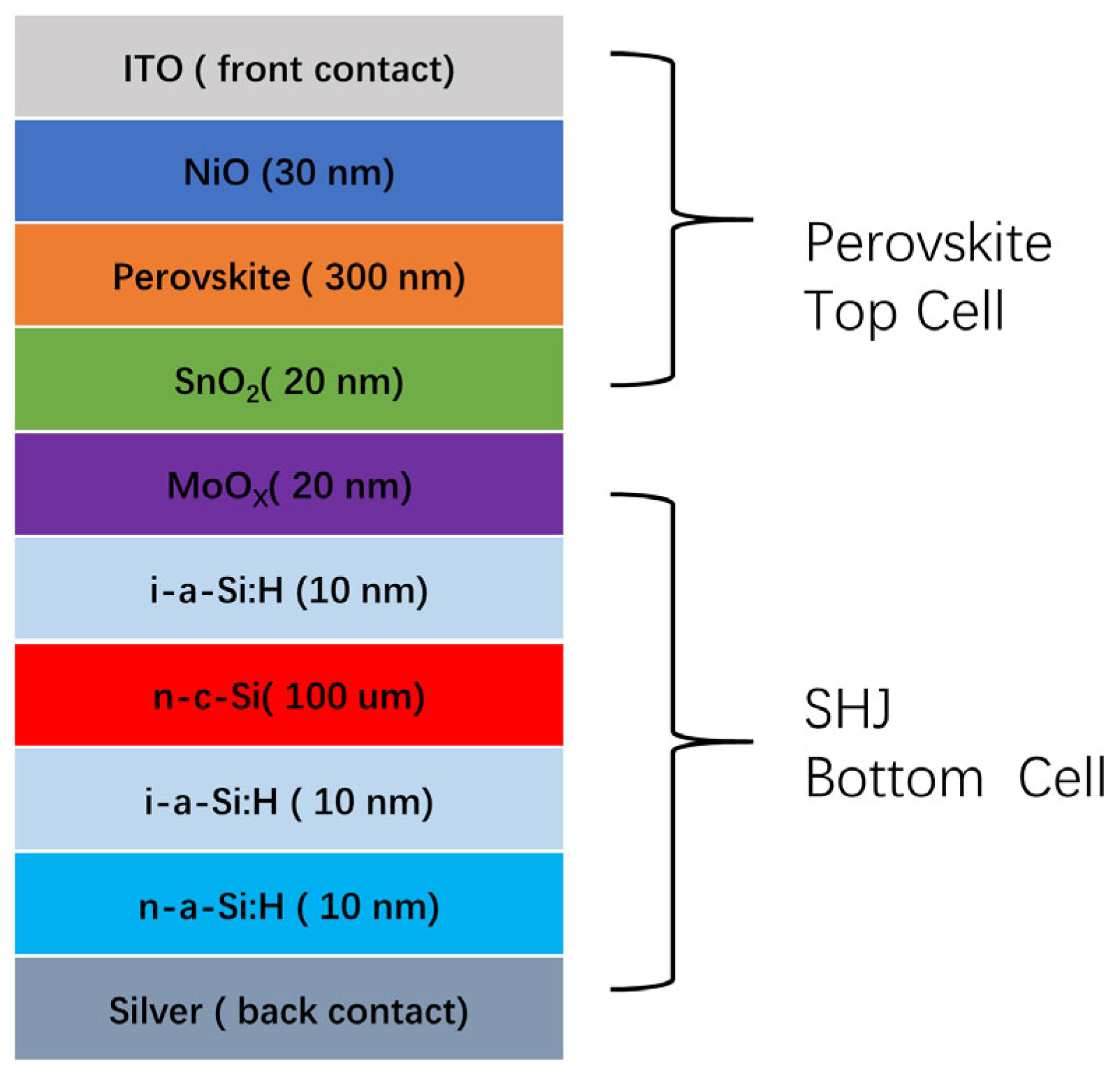
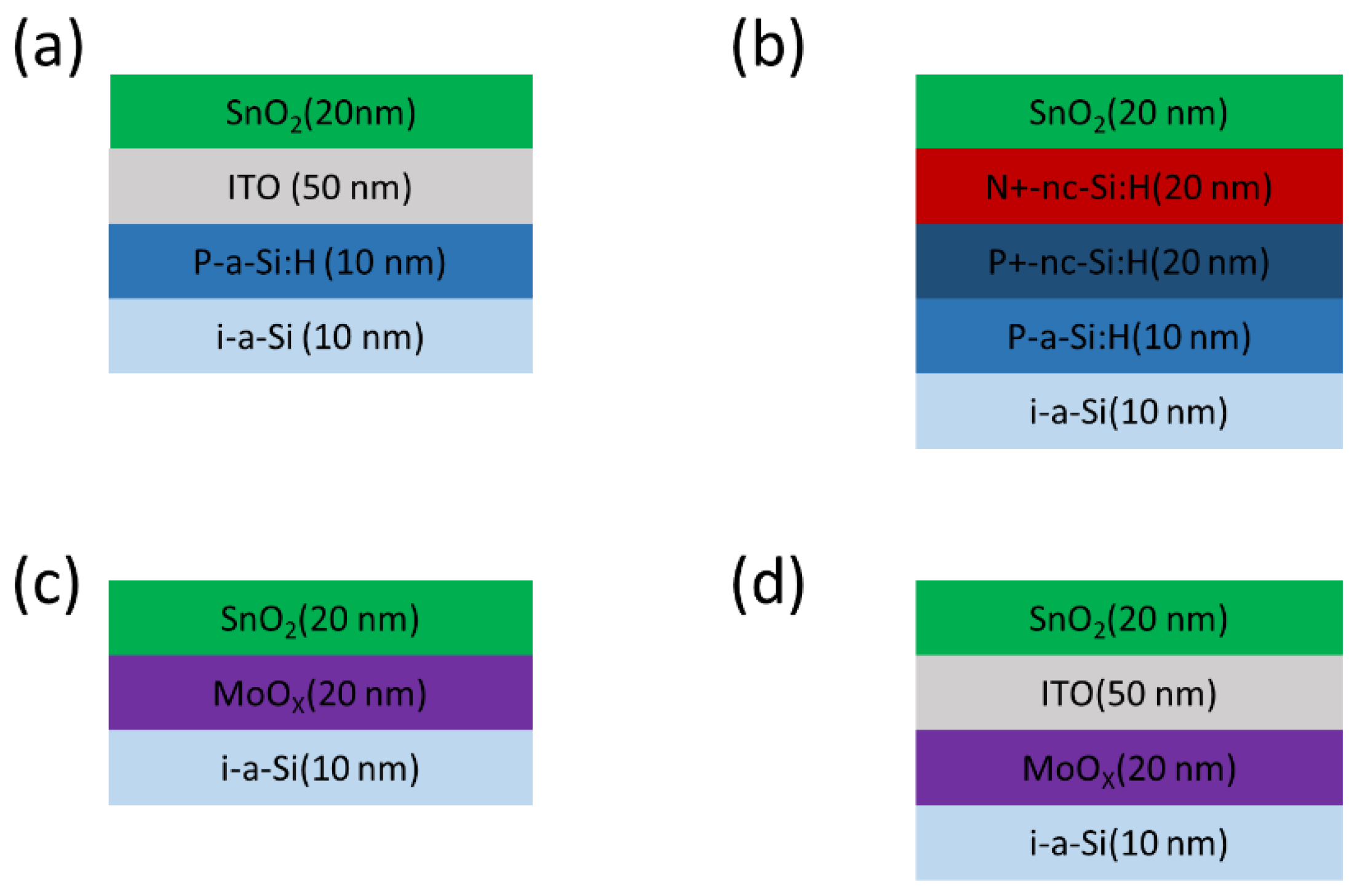

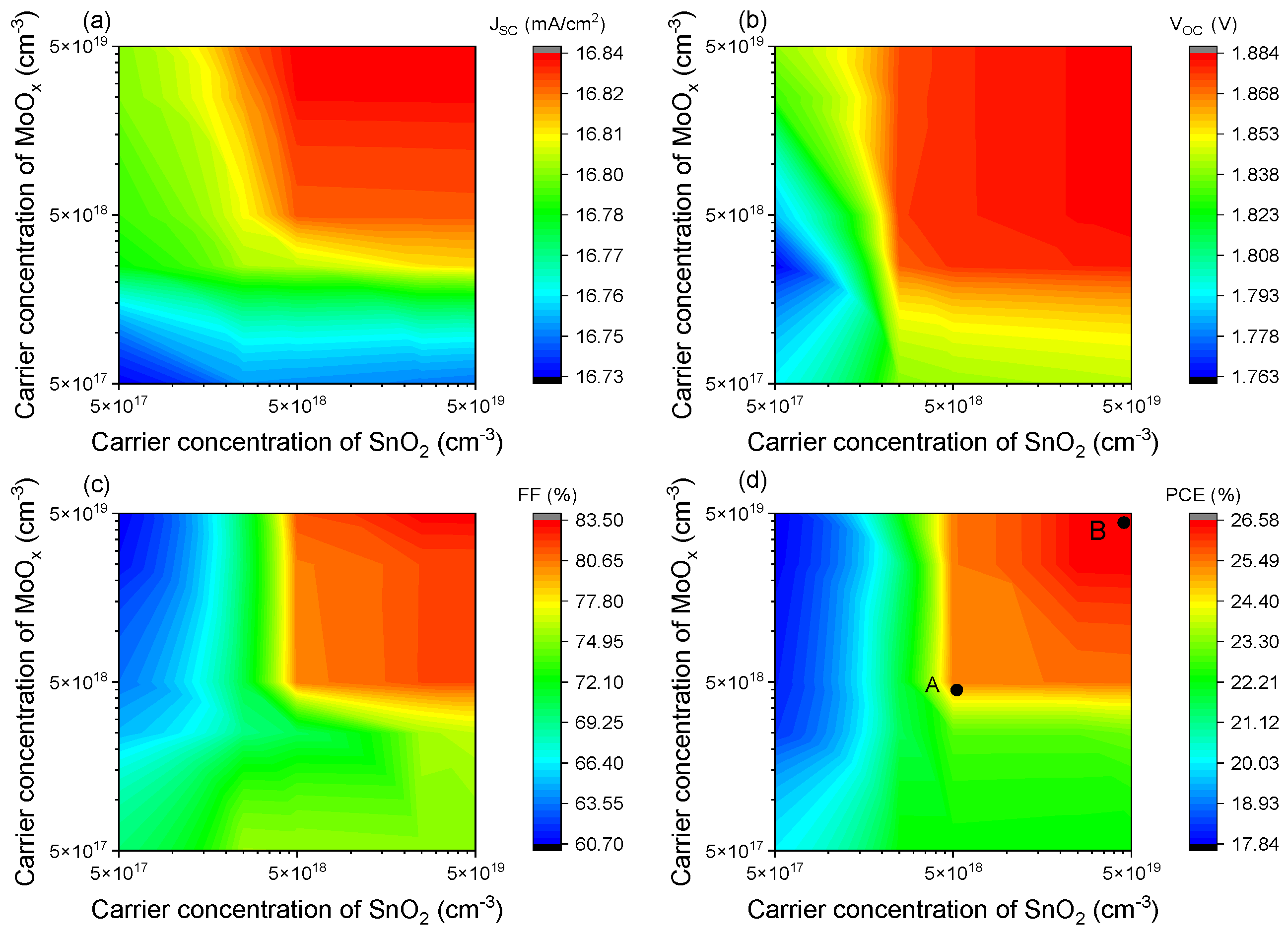
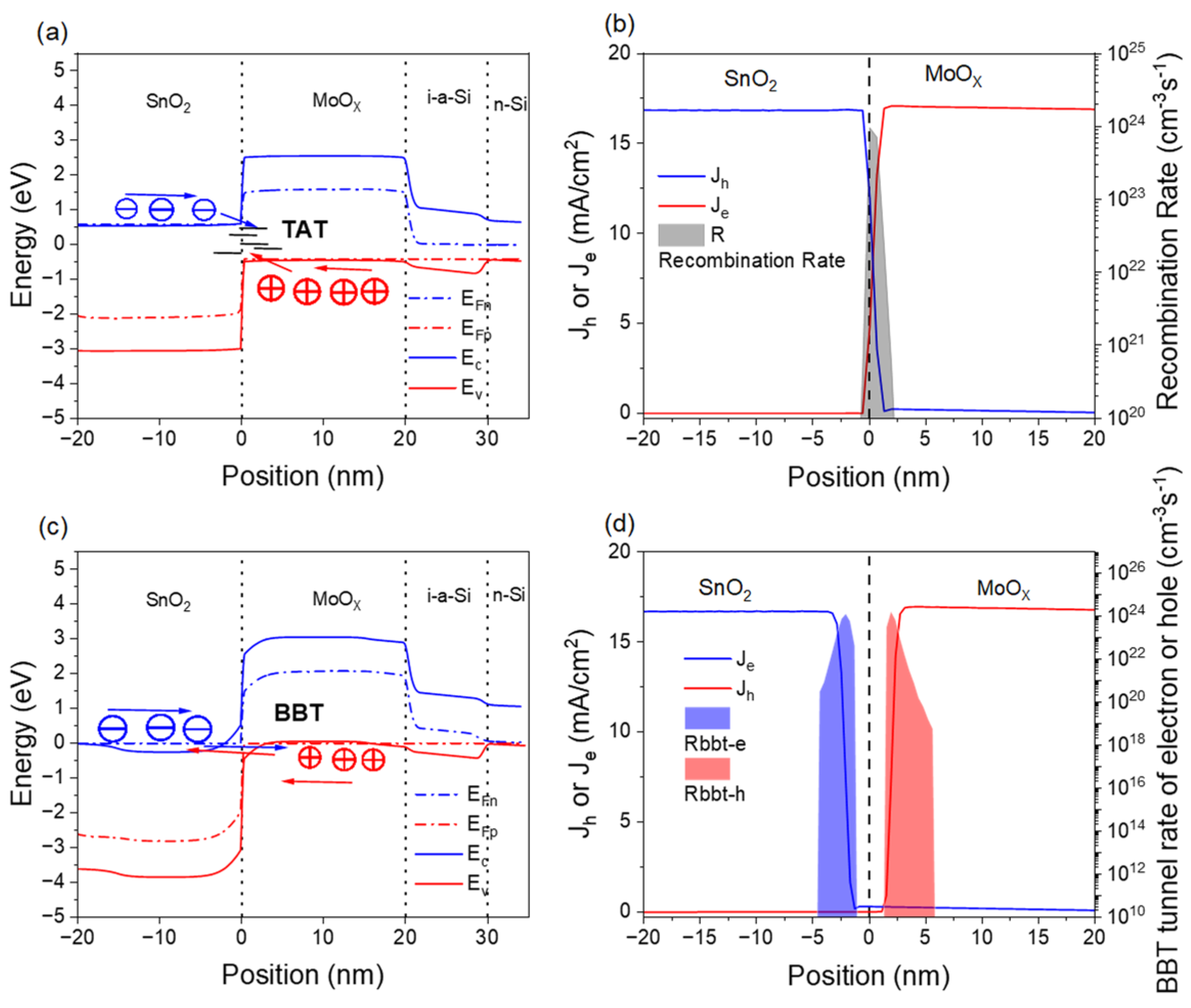
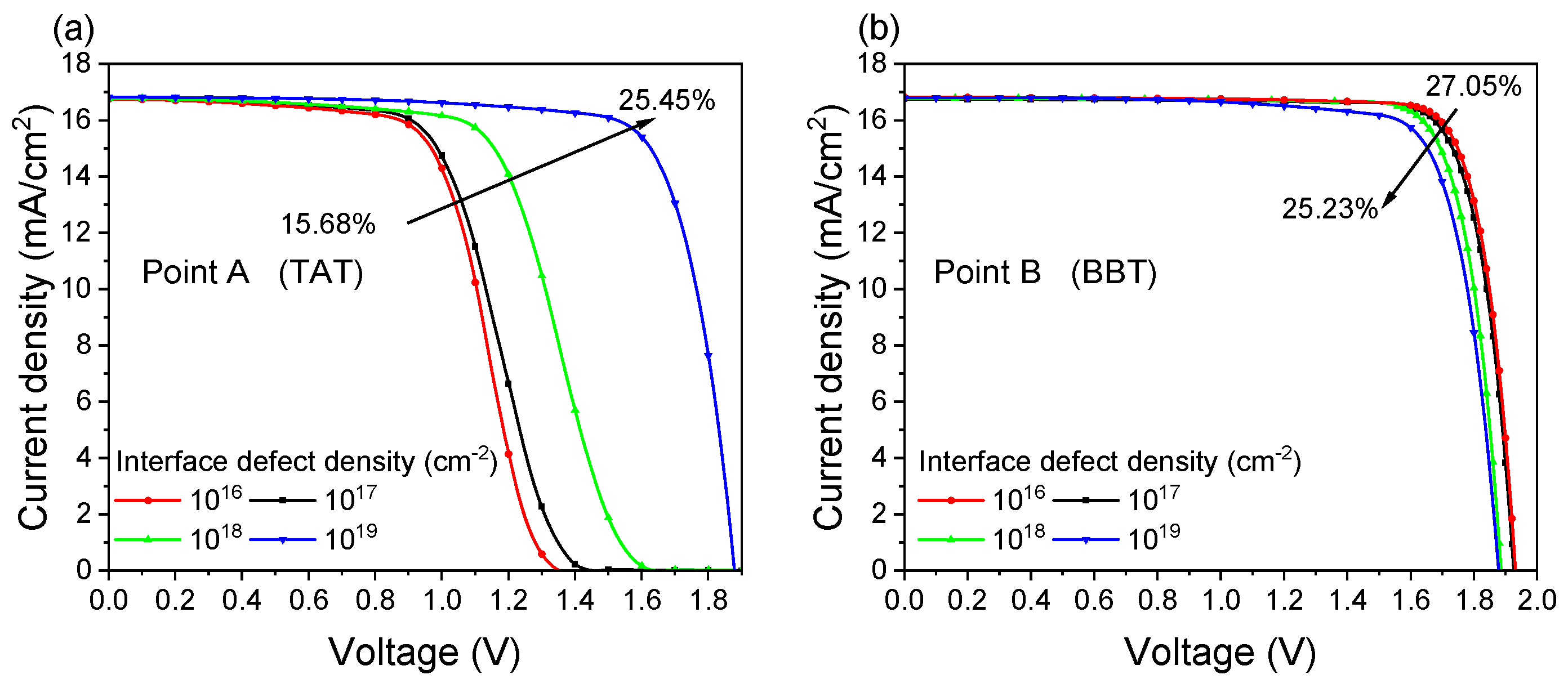
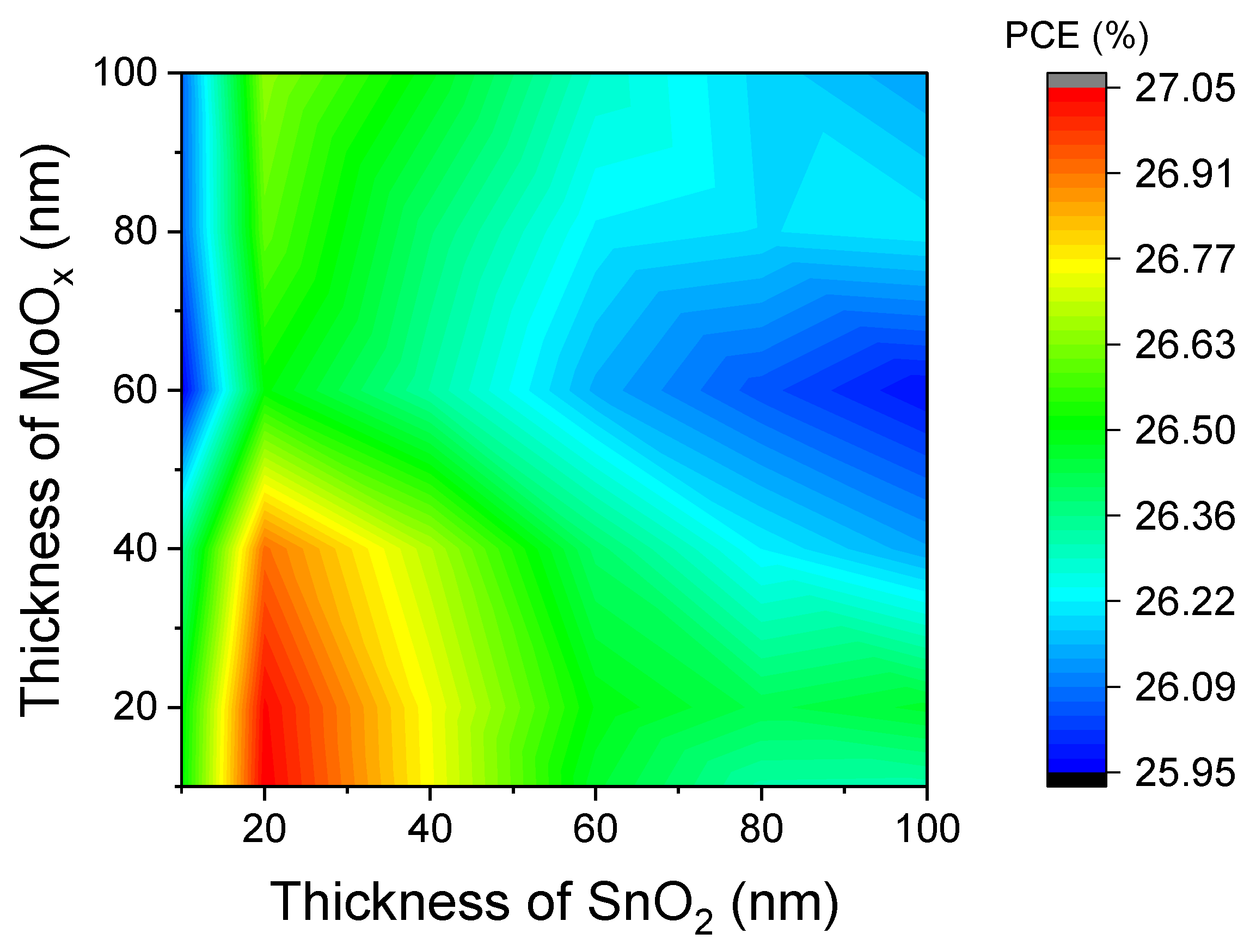
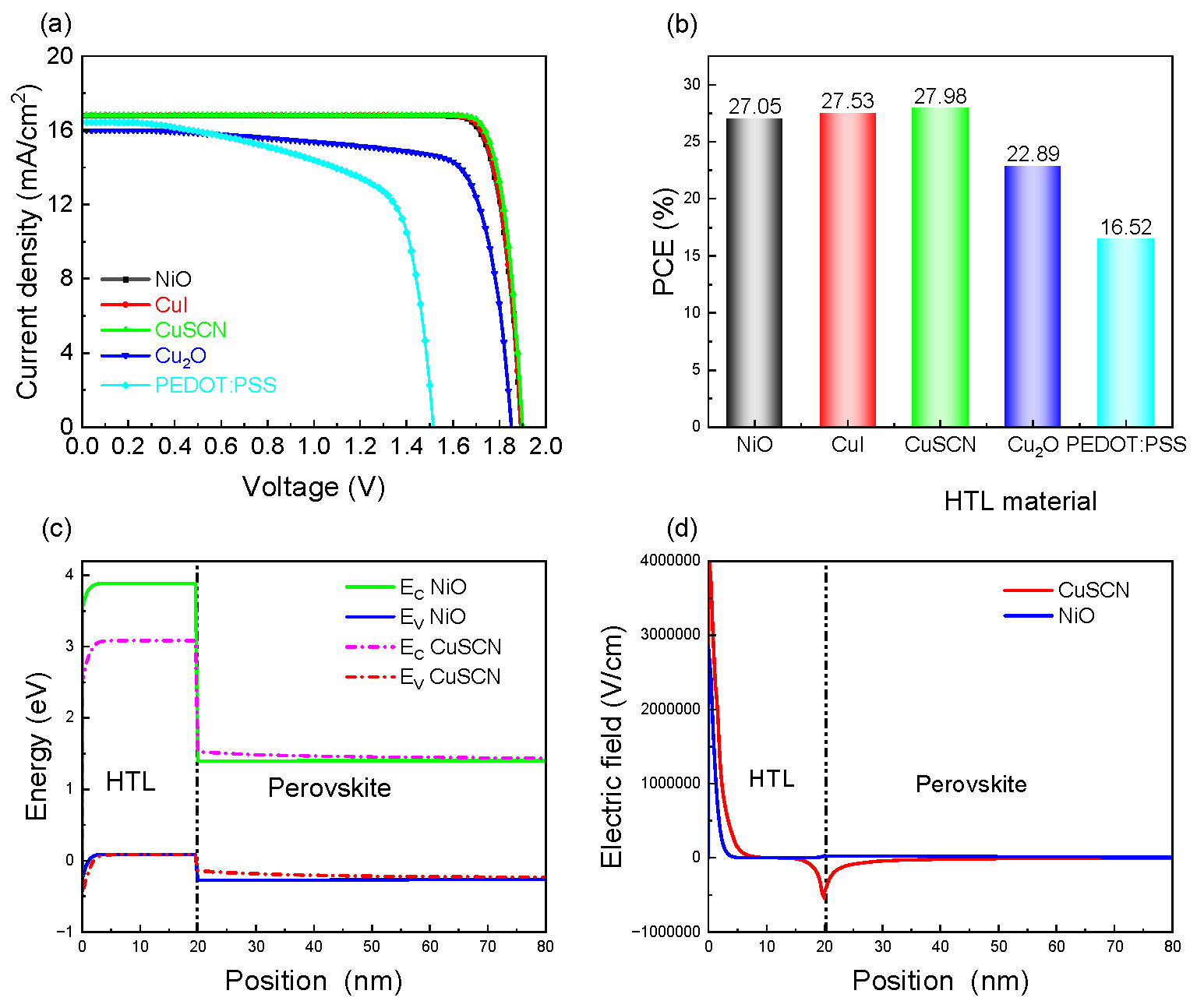
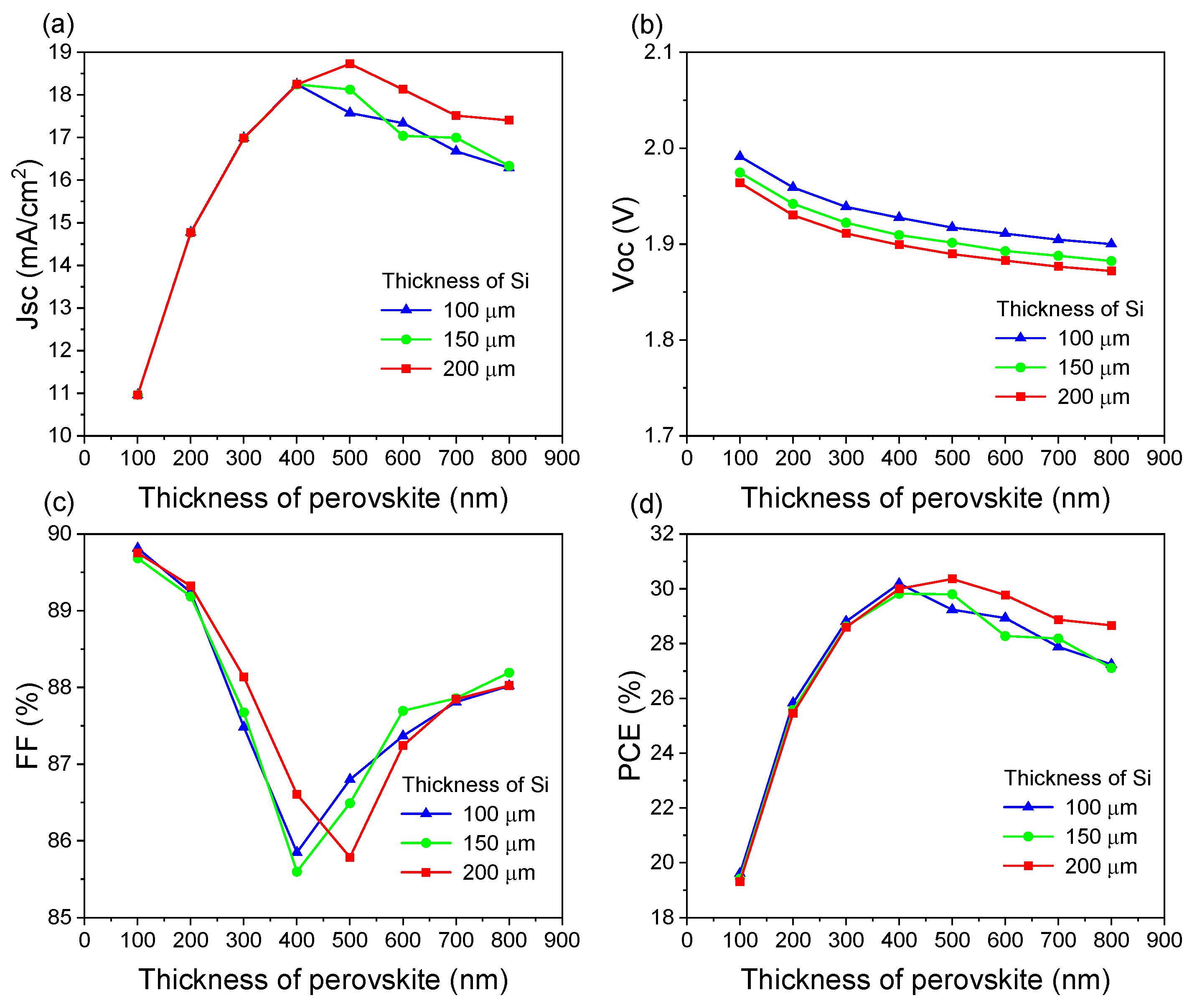

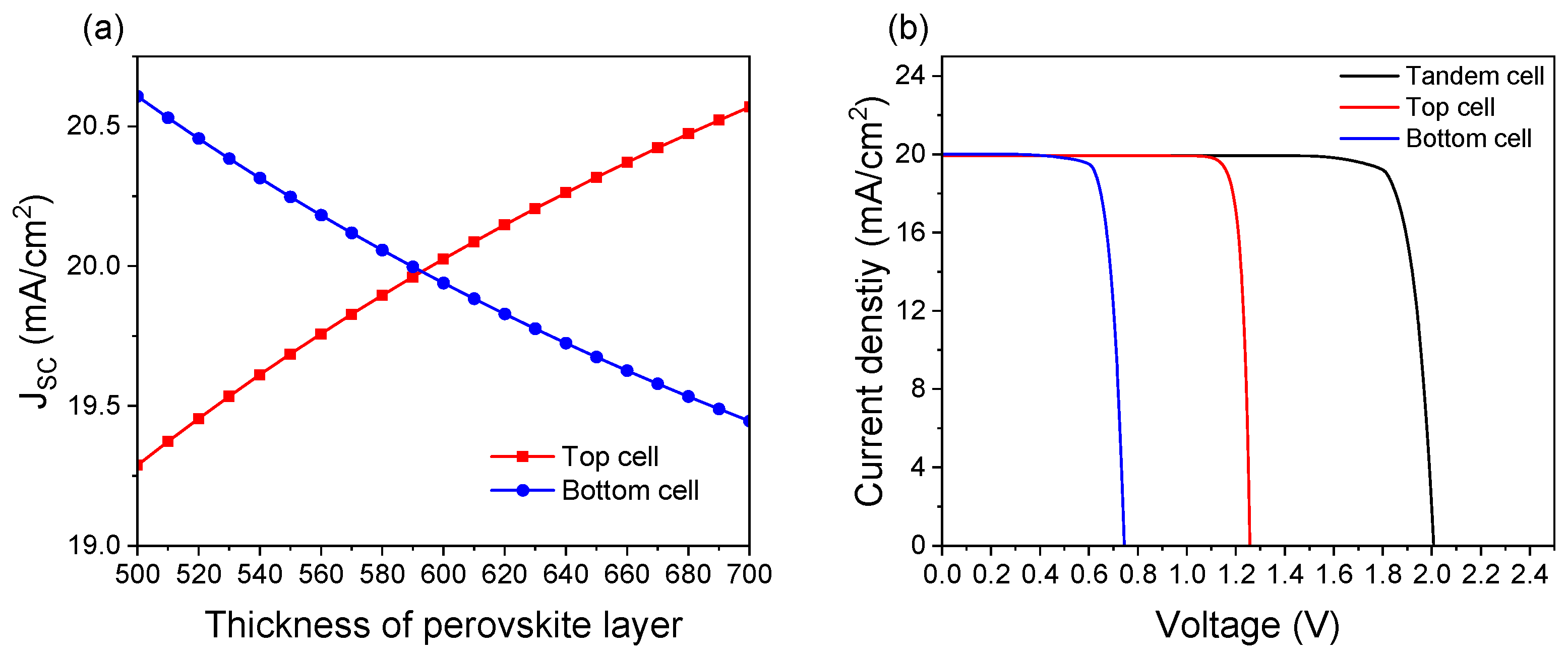
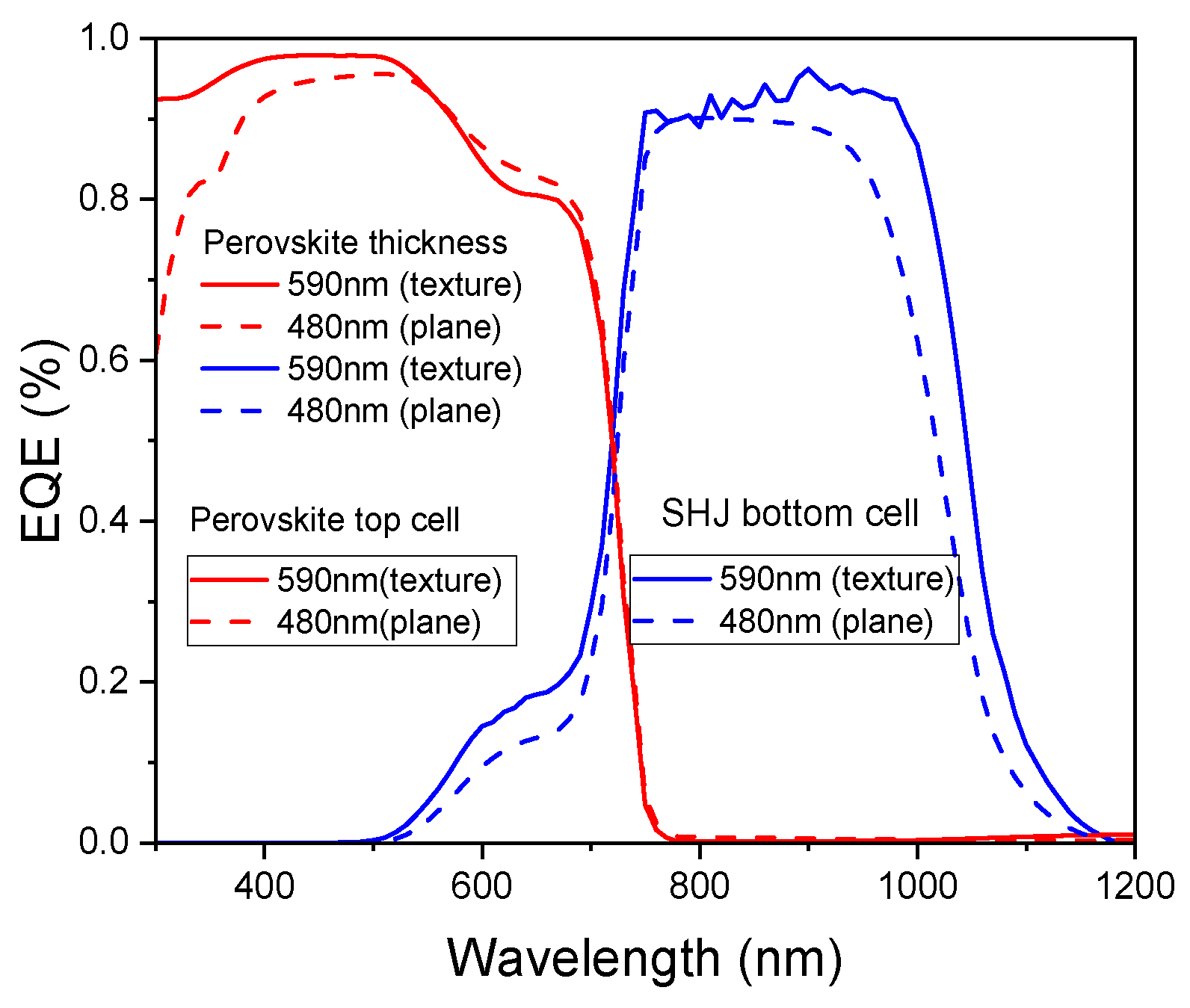
| Parameters | NiO | Perovskite | SnO2 | n-c-Si | i-a-Si:H | n-a-Si:H | MoOX |
|---|---|---|---|---|---|---|---|
| Thickness (um) | 0.03 | 0.3 | 0.02 | 100 | 0.01 | 0.01 | 0.02 |
| Bandgap, Eg (eV) | 1.4 | 1.7 | 9 | 1.12 | 1.72 | 1.72 | 3 |
| Electron affinity, χ (eV) | 3.8 | 4.05 | 4.4 | 4.05 | 3.86 | 3.86 | 2.5 |
| Relative permittivity, ε | 10.7 | 6.5 | 3.6 | 11.8 | 11.8 | 11.8 | 5.6 |
| Effective conduction band density, NC (cm−3) | 2.8 × 1019 | 1 × 1020 | 4 × 1018 | 2.8 × 1018 | 1 × 1020 | 1 × 1020 | 2.8 × 1018 |
| Effective valance band density, NV (cm−3) | 1 × 1019 | 1 × 1020 | 1 × 1018 | 1 × 1019 | 1 × 1020 | 1 × 1020 | 2 × 1019 |
| Mobility of electrons, μn (cm2/Vs) | 12 | 8.16 | 10 | 1240 | 20 | 20 | 25 |
| Mobility of holes, μp (cm2/Vs) | 2.8 | 8 | 10 | 451 | 5 | 5 | 100 |
| Donor doping density, ND (cm−3) | - | - | 1 × 1018 | 5 × 1015 | - | 1 × 1018 | - |
| Acceptor doping density, NA (cm−3) | 1 × 1018 | 1 × 1016 | - | - | - | - | 1 × 1018 |
| Lifetime of electron, τn (s) | 1 × 10−7 | 1 × 10−6 | 1 × 10−7 | 1 × 10−6 | 1 × 10−5 | 1 × 10−7 | 1 × 10−6 |
| Lifetime of hole, τp (s) | 1 × 10−7 | 1 × 10−6 | 1 × 10−7 | 1 × 10−6 | 1 × 10−5 | 1 × 10−7 | 1 × 10−6 |
| Parameters | Bulk Defects | Interface Defects | ||||
|---|---|---|---|---|---|---|
| NiO | Perovskite | SnO2 | NiO/Perovskite | Perovskite/SnO2 | SnO2/MoOX | |
| Defect type | Acceptor | Acceptor | Donor | Acceptor | Acceptor | Neutral |
| Energy level | Midgap | Midgap | Midgap | Midgap | Midgap | Midgap |
| Defect density | 1 × 1016 cm−3 | 1 × 1014 cm−3 | 1 × 1016 cm−3 | 1 × 1013 cm−2 | 1 × 1013 cm−2 | 1 × 1018 cm−2 |
| Parameters | CuI | CuSCN | Cu2O | PEDOT:PSS |
|---|---|---|---|---|
| Thickness (nm) | 20 | 20 | 20 | 20 |
| Bandgap, Eg (eV) | 2.1 | 3.6 | 2.1 | 2.2 |
| Electron affinity, χ (eV) | 2.98 | 1.7 | 3.2 | 2.9 |
| Relative permittivity, ε | 6.5 | 10 | 7.1 | 3 |
| Mobility of electrons, μn (cm2/Vs) | 100 | 100 | 111 | 0.02 |
| Mobility of holes, μp (cm2/Vs) | 43.9 | 25 | 80 | 0.02 |
| Acceptor doping density, NA (cm−3) | 1 × 1018 | 1 × 1018 | 1 × 1018 | 1 × 1018 |
| Effective conduction band density, NC (cm−3) | 2.8 × 1019 | 2.2 × 1019 | 2.5 × 1019 | 2.2 × 1015 |
| Effective valance band density, NV (cm−3) | 1 × 1019 | 1.8 × 1018 | 1.8 × 1019 | 2.2 × 1019 |
| Recombination Layer | JSC (mA/cm2) | VOC (V) | FF (%) | PCE (%) |
|---|---|---|---|---|
| ITO | 15.45 | 1.81 | 88.04 | 24.63 |
| p+-nc-Si:H/n+-nc-Si:H | 16.51 | 1.89 | 79.31 | 24.78 |
| SnO2/MoOX | 16.82 | 1.87 | 80.5 | 25.45 |
| SnO2/ITO/MoOX | 15.72 | 1.81 | 87.9 | 25.04 |
| JSC (mA/cm2) | VOC (V) | FF (%) | PCE (%) | |
|---|---|---|---|---|
| Perovskite top cell | 20.23 | 1.266 | 88.84 | 22.75 |
| SHJ bottom cell | 20.30 | 0.742 | 85.05 | 12.81 |
| Perovskite/SHJ tandem cell | 20.23 | 2.008 | 86.92 | 35.31 |
Disclaimer/Publisher’s Note: The statements, opinions and data contained in all publications are solely those of the individual author(s) and contributor(s) and not of MDPI and/or the editor(s). MDPI and/or the editor(s) disclaim responsibility for any injury to people or property resulting from any ideas, methods, instructions or products referred to in the content. |
© 2025 by the authors. Licensee MDPI, Basel, Switzerland. This article is an open access article distributed under the terms and conditions of the Creative Commons Attribution (CC BY) license (https://creativecommons.org/licenses/by/4.0/).
Share and Cite
Lu, T.-Y.; Wang, J.; Feng, X.-D. Numerical Investigation of Perovskite/Silicon Heterojunction Tandem Solar Cell with a Dual-Functional Layer of MoOX. Materials 2025, 18, 1438. https://doi.org/10.3390/ma18071438
Lu T-Y, Wang J, Feng X-D. Numerical Investigation of Perovskite/Silicon Heterojunction Tandem Solar Cell with a Dual-Functional Layer of MoOX. Materials. 2025; 18(7):1438. https://doi.org/10.3390/ma18071438
Chicago/Turabian StyleLu, Tian-Yu, Jin Wang, and Xiao-Dong Feng. 2025. "Numerical Investigation of Perovskite/Silicon Heterojunction Tandem Solar Cell with a Dual-Functional Layer of MoOX" Materials 18, no. 7: 1438. https://doi.org/10.3390/ma18071438
APA StyleLu, T.-Y., Wang, J., & Feng, X.-D. (2025). Numerical Investigation of Perovskite/Silicon Heterojunction Tandem Solar Cell with a Dual-Functional Layer of MoOX. Materials, 18(7), 1438. https://doi.org/10.3390/ma18071438





